
Collalto is a village in the province of Treviso in northern Italy, forming a 'frazione' or part of the municipality of Susegana.

Collalto is a village in the province of Treviso in northern Italy, forming a 'frazione' or part of the municipality of Susegana.
At the northern end of the municipality and about 6 kilometres from its capital, the territory of Collalto is mainly hilly and wooded. At its highest point it overlooks the Piave Quarter and the vast Pieve di Soligo plain, its hills and the Bellunes Alps. A long nature walk along the Collalto-via Tombola road connects Collalto castle with the Castello di San Salvatore e Susegana.
There is evidence of human occupation at Collalto in the prehistoric period and it later gained some importance as a mercantile route, as shown by ancient Roman bridge in Mercatelli Colfosco near Sant'Anna church - it is overgrown with vegetation but the central arch survives, possibly forming part of the Via Claudia Augusta across the Passo Praderadego or Valdobbiadene and connecting the Venetian plain with Belluno. The area had a cult of the warrior saints saint George and saint Martin, possibly pointing to an early Lombard settlement in the area, though the first documentary evidence for a settlement comes from the 12th century, with the foundation of a small fort which formed the nucleus for the present-day castle.

Trevisan nobles took this fort and castle on the 'High Hill' or Colle Alto as their seat - Ensedisio I is considered as the castle's founder in 1110 and it became a fiefdom of the house of Collalto, entrusted with controlling the lords of Piave. The castle was frequently attacked and damaged, especially by the rival Da Camino family. In 1245 the counts also acquired the hill at San Salvatore, also in Susegana, where count Raimbaut VIII Collalto built a castle shortly afterwards, which led to a decline in Collalto's military importance. In 1312 the family's feudal rights were confirmed by Arrigo VII. The castle at Collalto controlled the towns of Barbisano, Falzè di Piave and Sernaglia, whilst that at San Salvatore did the same for Colfosco, Refrontolo, Santa Lucia and Susegana. Blessed Giuliana di Collalto was born either in Susegana or in the castle in 1186.
With the rise of the Republic of Venice and the ensuing period of peace, the castle lost what remained of its importance and became a Franciscan monastery and important cultural centre, hosting artists such as il Pordenone and Francesco da Milano. With the arrival of Napoleon, Collalto was demoted from a noble seat to merely a frazione of San Salvador (now known as Susegana), whilst the monastery was suppressed and converted into a mill. This began a slow decline which culminated during the First World War - the settlement was on the Piave front and the town and monastery were both almost completely destroyed by Italian artillery firing from Montello, though the tower survived. The Susegana-Pieve di Soligo tramway (run by the Società Veneta until 1931) was also severely damaged in the war - Collalto had been given a stop on its route in 1913 and the line temporarily became a military railway during the war, with an extension to Revine Lago.
The castle could not be restored after the war (traces of its walls still survive, but otherwise Collalto revived in the inter-war period - in 1927 the current parish church was opened, designed by Domenico Rupolo [1] - it was restored in 2009.
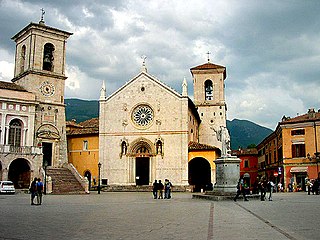
Norcia, traditionally known in English by its Latin name of Nursia, is a town and comune in the province of Perugia (Italy) in southeastern Umbria. Unlike many ancient towns, it is located in a wide plain abutting the Monti Sibillini, a subrange of the Apennines with some of its highest peaks, near the Sordo River, a small stream that eventually flows into the Nera. The town is popularly associated with the Valnerina. It is a member of the I Borghi più belli d'Italia association.

Capo di Ponte is an Italian comune in Val Camonica, province of Brescia, in Lombardy.

Poggibonsi is a town in the province of Siena, Tuscany, central Italy. It is located on the river Elsa and is the main centre of the Valdelsa Valley.

Greve in Chianti is a town and comune (municipality) in the Metropolitan City of Florence, Tuscany, Italy. It is located about 31 kilometres (19 mi) south of Florence and 42 kilometres (26 mi) north of Siena.
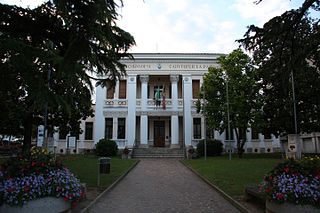
Cornuda is a comune with 6,325 inhabitants in the province of Treviso.

Refrontolo is a comune (municipality) in the Province of Treviso in the Italian region Veneto, located about 50 kilometres north of Venice and about 30 km (19 mi) north of Treviso, representing the third smallest municipality by number of inhabitants (1,732) in the province, preceded only by Portobuffolé and Monfumo. It is located in a hilly viewpoint between Quartier del Piave and Montello, and it is crossed by the Prosecco and Conegliano-Valdobbiadene Hills Wine Road established in 1966. The municipality is in fact famous for the production of the Marzemino wine. Since July 7, 2019, Refrontolo's hills have been inscribed as an UNESCO World Heritage Site as The Prosecco Hills of Conegliano and Valdobbiadene.

Susegana is a comune (municipality) in the Province of Treviso in the Italian region Veneto, located about 45 km (28 mi) north of Venice and about 20 km (12 mi) north of Treviso.
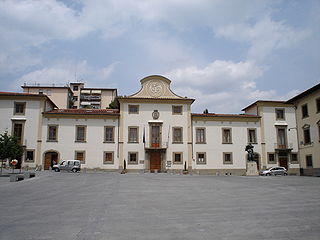
Pontassieve is a comune (municipality) in the Metropolitan City of Florence in the Italian region Tuscany, located about 14 kilometres (9 mi) east of Florence, nearby Fiesole, at the confluence of the Arno and Sieve rivers.

San Casciano in Val di Pesa is a comune (municipality) in the Metropolitan City of Florence in the Italian region Tuscany, located about 15 kilometres (9 mi) southwest of Florence.

Cascina is a comune (municipality) in the Province of Pisa in the Italian region Tuscany, located about 60 kilometres (37 mi) west of Florence and about 13 kilometres (8 mi) southeast of Pisa.

Carbonera is a comune with 11,196 inhabitants in the province of Treviso, Veneto, northern Italy. It borders the municipalities of Treviso, Villorba, Spresiano, Maserada sul Piave, Breda di Piave and San Biagio di Callalta. The municipality of Carbonera includes the following villages or frazioni: Mignagola, Pezzan, Biban, San Giacomo di Musestrelle and Vascon.

The da Camino were an Italian noble family whose fame is connected to the mediaeval history of the March of Treviso, a city of which they were lords for a while.

Montello is a hill in the province of Treviso, Veneto, northern Italy, and the site of a World War I battle.

Camino is a village in the municipality of Oderzo, in the province of Treviso, region Veneto, in Italy. Camino lies in the heart of the Venetian plain, about 66 kilometres to the northeast of Venice.
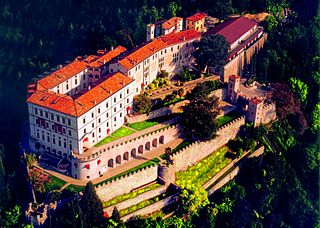
CastelBrando, former Castrum Costae, is a medieval castle situated on a dolomite limestone rock at an elevation of 370 m (1,210 ft) above sea level, overlooking the villages of Cison di Valmarino and Valmareno, Northern Italy. The name CastelBrando is due to the name Brandolini, the ancient family from Forlì, who were the Lords of the castle.

Batignano is a small town in southern Tuscany, a frazione of the comune of Grosseto, positioned at about 10 km north-east of the capital on one of the last foot-hills of the valley of Ombrone which dominated the ancient city of Roselle.

The Castello San Salvatore is a castle in Susegana, in the Province of Treviso, Veneto, Italy. It was built in the 13th and 14th centuries, and is one of the largest castles in northern Italy.

The House of Collalto is an old and distinguished Austro-Italian noble house of Lombard origin, named after their seat at Collalto in Susegana, now in the Province of Treviso in Italy. Throughout its history, the house had their possessions in Italy, Austria and Moravia. Its name comes from Italian.
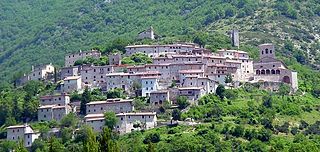
Campi, also known as Campi di Norcia, is a frazione of the comune of Norcia in the province of Perugia, Umbria, Italy. The medieval village has a population of around 200 people. Many of its landmarks, including the Church of San Salvatore, were heavily damaged during the October 2016 Central Italy earthquakes.
Santa Lucia may refer to: